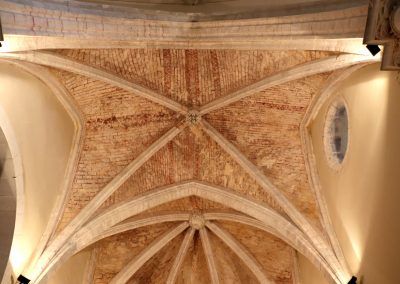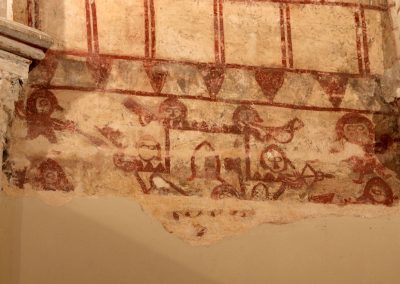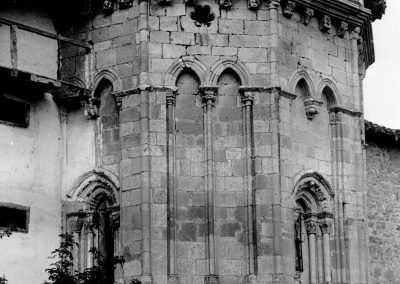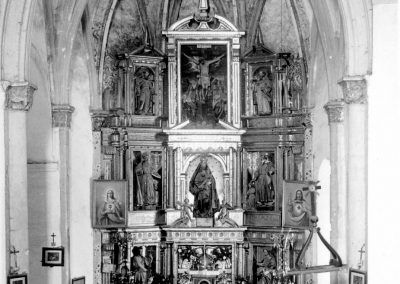
A digital gate open to heritage

Introduction
Slightly apart from the main roads, the small town of Añua still preserves the emblazoned palaces and a magnificent church that tell us about its rich past. Since the 14th century, and due to a privilege issued by the King Alphonse XI of Castile, it is part of the municipality of Elburgo. Although today it is not part of the official route of the Way of Saint James, the roads varied over time and this church has traditionally been considered as one of the great milestones for pilgrims. In 1294, chronicles tell us about a contribution of the town of 900 maravedíes to a campaign against the Arabs, a far from inconsiderable amount that informs us about an economically prosperous situation. In that same century, the building of the magnificent octagonal apse of the church started, one of the medieval jewels of the Alavese Plains.
Medieval paintings
In the restoration of the nineties, a series of medieval paintings that cover the vaults and part of the walls of the east end were discovered. On the web spandrels of the vaults, in addition to red ashlar masonry, there are some decorative stripes with stars and flowers inscribed in circles. The walls are covered with a wider masonry, possibly older, in red and black. A border of geometrical and vegetal motifs runs along the walls as an impost and, below, an unfinished scene is preserved, formed by some figures of soldiers defending a castle, theme that also appears in the church of Alaiza. The windows also feature an interesting polychromy with yellow, red and black tones that cover the sculpture work and also give a marble effect to the columns.
In the nineties, numerous and important restorations were carried out in the building that transformed it in a noticeable way. On the one hand, the buildings that were attached to it were removed and, that way, sculptural elements that had been hidden were brought to light. Amazing mural paintings also appeared, as the fortified city that could be saved by tearing it from the wall, which can be today seen inside the nave. On the other hand, a complete restoration of the interior was carried out, bringing to light the original paintings. For this purpose, the baroque altarpiece was moved away and placed in a side chapel, and the medieval windows that had been covered could also be rescued. The old photographs allow us to see these important changes perfectly, as we can still see the school building that connected with the porch.
The church of the Nativity of Our Lady
The apse
The apse of the church of Añua is one of the richest models of medieval art in the entire Alavese Plains. It is a work from the early 13th century, built at a time of particular interest when the masters that worked on the area started to experiment with Gothic forms that came from France as well as other places of the peninsular kingdoms. Thus, with one foot in the Romanesque tradition and the other in the new construction trends, they built a surprisingly ambitious work for the humble rural context in which it is located. The five wall sections feature a series of blind arcades with columns that highlight the verticality of the building. Besides, some of the walls have beautiful flower-shaped oculi that give the temple a great personality.
Corbels
The upper cornice presents one of the most interesting collections of corbels in the province. Running along the apse from its south side northwards, we can see grotesque heads and faces of animals and people, monsters, vegetal elements… but, above all, characters like a minstrel with a pointed hat, a stonemason with his tool and a nice couple of exhibitionists stand out.
Inside the temple
The entrance to the building is made through a Gothic door carried out by a workshop different from the one that made the east end. Inside the temple, we perfectly see the extension that was made in the 16th century. Preserving the medieval east end and the chancel, the main body of the nave was raised with two sections covered with good tierceron vaults. The web spandrels are decorated with Renaissance grisaille paintings, in which saints, apostles, evangelists and characters of the Old Testament appear.
The possible promoters of this extension, the Otazu-Guevara family, built a funeral chapel for themselves on the north wall of the church. The entrance arch still has Gothic elements, while the paintings that cover the vaults are in Renaissance style. Until the recent renovations, the triptych of Saint Sebastian was in this chapel, a jewel of the mid-16th century that has few parallels in the province. In the centre, we see a sculpture of the Saint, while the four paintings of the doors describe the most important moments of his hagiography
A century later, in the 17th century, the sacristy was added, which today is covered by the apse in its northern area. Converted into a baptistery, it still preserves the magnificent vault made by Pedro de la Cuesta that connects perfectly with the Late Gothic chapel of the Otazu-Guevara family.
The main altarpiece, which is today in the aforementioned chapel, was in the east end of the church until a few decades ago. It is a simple work from the 17th century, formed by three horizontal and three vertical sections, whose gilding finished almost at the end of the 18th century. In the first panel, flanking the tabernacle, Saint John the Baptist and Saint John the Evangelist appear; in the second, the carving of the Virgin Mary is presented, titular figure of the temple, accompanied by Saint Joachim and Saint Joseph; finally, in the upper panel, we find the effigies of Saint Dominic and Saint Francis, with the scene of the Calvary in the central part.
Photo credits:
Current photographs: © Alava Medieval / Erdi Aroko Araba
Old photographs: Archive of the Historical Territory of Álava





































